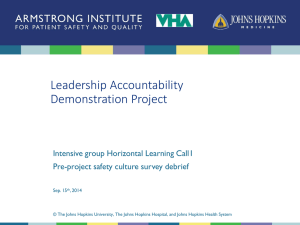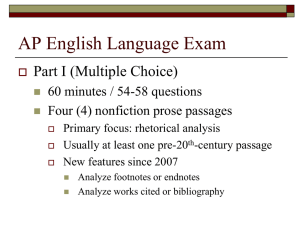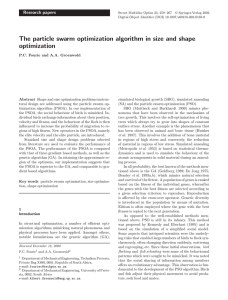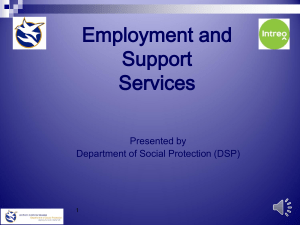Introduction - Pakistan Society of Actuaries
advertisement
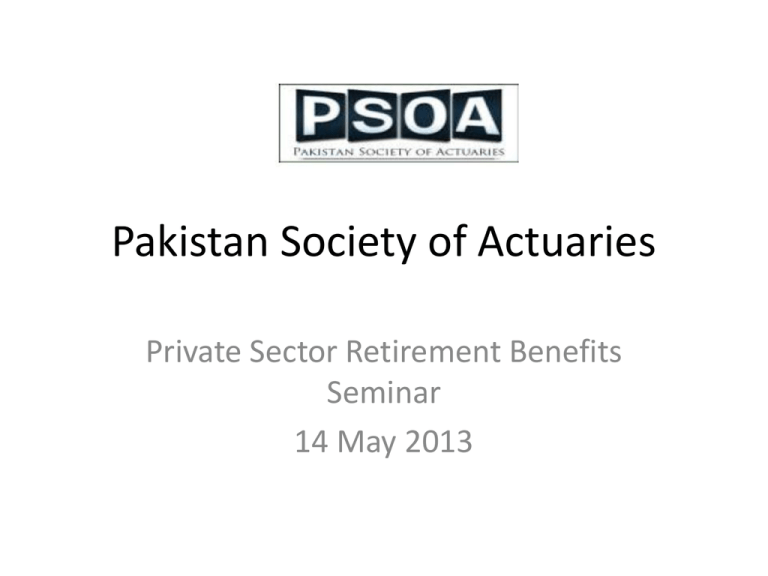
Pakistan Society of Actuaries Private Sector Retirement Benefits Seminar 14 May 2013 Introduction to PSOA • Existed since the 1970s • Operated as an informal society until 2001 when it was formally incorporated as a S42 company • Recognized universally (including regulatory agencies) as a professional body representing the actuarial profession in Pakistan PSOA Overview • Managed by a Council which has a 2 year term and which consists of 7 members • Current Membership of 142 Including 39 Fellows and 30 Associates • A significant number of members located outside Pakistan Involvement with Regulatory Bodies • Actively liaise with the Securities and Exchange Commission of Pakistan with respect to insurance regulation – A committee of Appointed Actuaries regularly invite a representative of the SECP to attend quarterly meetings • The PSOA has representation on a committee of the Institute of Chartered Accountants of Pakistan which recommends accounting regulations for insurance companies to the SECP • Although actuaries are deeply involved in retirement schemes, the PSOA’s role in this arena has not been as involved, largely due to the lack of a clearly defined regulatory structure. PSOA Achievements • Apart from its involvement with insurance regulation the PSOA has also – Developed some guidance related to the valuation of retirement schemes – Developed guidance for appointed actuaries for reporting to the management of life insurance companies • Early this year the PSOA also published, with the help of State Life’s actuarial division, a new mortality table based on the mortality experience of the State Life Insurance Corporation between 2001 and 2005 – This replaces the EFU 61-66 table – Although meant for insured lives it is obvious that this may be used for the valuation of retirement benefit schemes with appropriate adjustments for mortality improvement Regulation of Retirement Schemes • The responsibility for regulation of retirement benefit schemes in Pakistan is not clearly defined. The only areas where there are clearly defined responsibilities are – the EOBI. However this provides only a very minimal pension leaving employers to provide the major part directly. – The VPS for which the SECP has regulatory responsibility • There is, however, a clear need for regulation with the main objective of ensuring protection of the interests of the retirement benefits of employees • India has separate regulators for Provident Funds and Pensions – Pension Fund Regulatory and Development Authority (set up in 2003) – Employees Provident Fund Organization Need for Action • There is certainly a need to act as sectors do not develop unless there is a clearly defined regulatory structure • Attempts to initiate regulatory initiatives relating to retirement schemes have been made earlier – The SECP attempted, in the early 2000s, to initiate a Chile style mandatory defined contribution model – In 2005 the SECP held a two day seminar in Lahore with a promise to follow up – this did not happen – The SECP initiated and introduced the Voluntary Pension Scheme regulation - we have a session later this morning to gauge the extent of its success and judge what the future holds for it • However nothing material has come about – perhaps due to lack of an owner Objective of Seminar • The objective of this seminar is largely to act as a catalyst to stimulate thought on how retirement schemes need to develop – This is especially required when there is a world wide trend to move away from defined benefit schemes to defined contributions schemes • The PSOA did conduct a similar seminar in 2003 but has not since been as active on this front as it should have been Need to Define Regulatory Responsibility • The success of initiatives is closely tied in with the effort made by stakeholders – a clear owner often being required for this – It is suggested that in the current regulatory environment the SECP is a natural owner – given that the vast bulk of private sector schemes are administered by corporate entities falling within the scope of its regulations • I hope that this aspect will be taken up by speakers and the audience as the day proceeds Thank You




